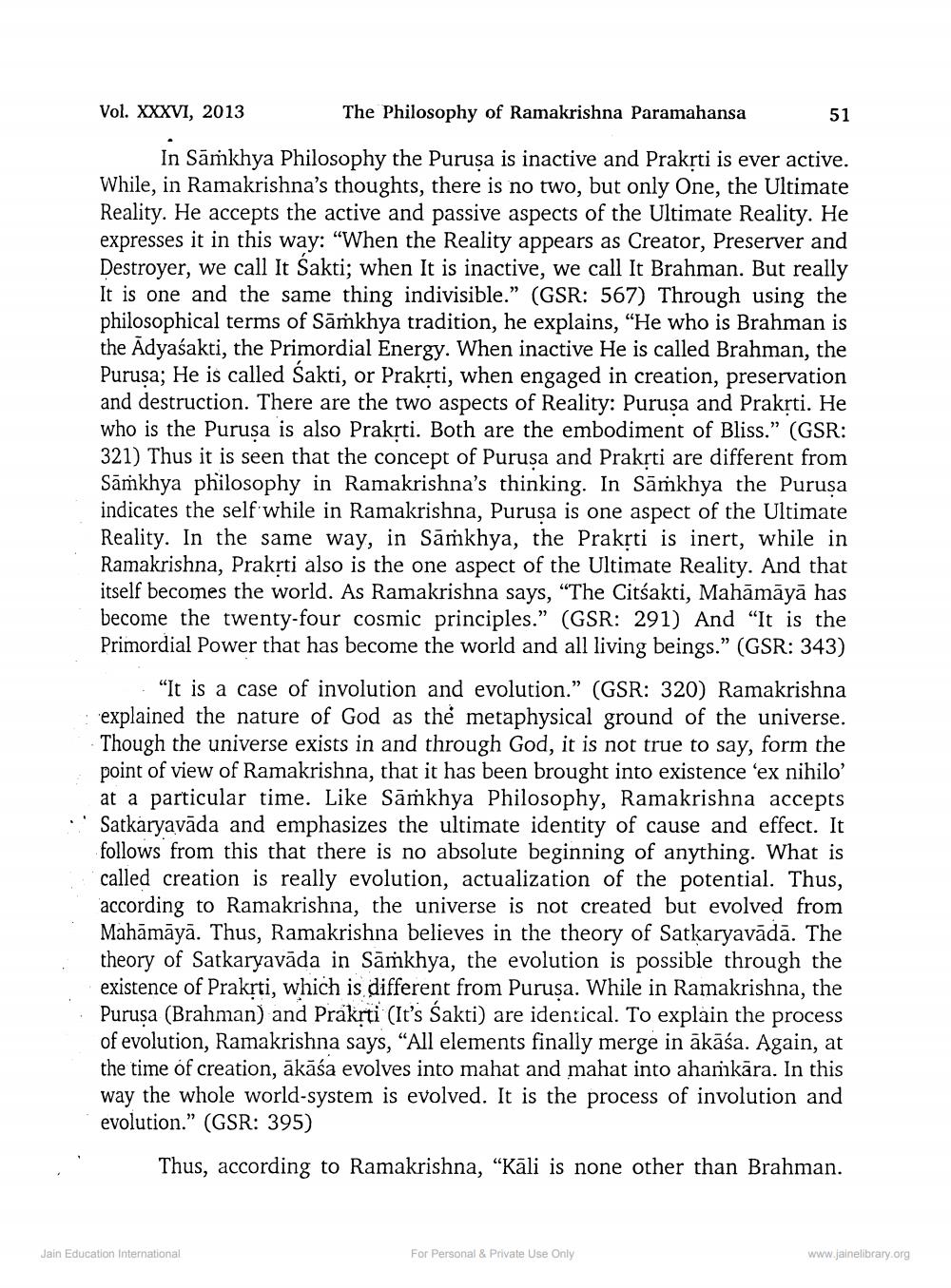________________
Vol. XXXVI, 2013
The Philosophy of Ramakrishna Paramahansa
51
In Sāmkhya Philosophy the Purusa is inactive and Prakrti is ever active. While, in Ramakrishna's thoughts, there is no two, but only One, the Ultimate Reality. He accepts the active and passive aspects of the Ultimate Reality. He expresses it in this way: "When the Reality appears as Creator, Preserver and Destroyer, we call It Sakti; when It is inactive, we call It Brahman. But really It is one and the same thing indivisible.” (GSR: 567) Through using the philosophical terms of Sāṁkhya tradition, he explains, "He who is Brahman is the Adyasakti, the Primordial Energy. When inactive He is called Brahman, the Purusa; He is called Sakti, or Prakrti, when engaged in creation, preservation and destruction. There are the two aspects of Reality: Purusa and Prakrti. He who is the Purusa is also Prakrti. Both are the embodiment of Bliss." (GSR: 321) Thus it is seen that the concept of Purusa and Prakrti are different from Samkhya philosophy in Ramakrishna's thinking. In Samkhya the Purusa indicates the self while in Ramakrishna, Purusa is one aspect of the Ultimate Reality. In the same way, in Samkhya, the Prakrti is inert, while in Ramakrishna, Prakrti also is the one aspect of the Ultimate Reality. And that itself becomes the world. As Ramakrishna says, “The Citsakti, Mahāmāyā has become the twenty-four cosmic principles." (GSR: 291) And “It is the Primordial Power that has become the world and all living beings." (GSR: 343)
"It is a case of involution and evolution.” (GSR: 320) Ramakrishna : explained the nature of God as the metaphysical ground of the universe.
Though the universe exists in and through God, it is not true to say, form the point of view of Ramakrishna, that it has been brought into existence ‘ex nihilo' at a particular time. Like Sāṁkhya Philosophy, Ramakrishna accepts Satkaryavāda and emphasizes the ultimate identity of cause and effect. It follows from this that there is no absolute beginning of anything. What is called creation is really evolution, actualization of the potential. Thus, according to Ramakrishna, the universe is not created but evolved from Mahāmāyā. Thus, Ramakrishna believes in the theory of Satkaryavādā. The theory of Satkaryavāda in Sāmkhya, the evolution is possible through the existence of Prakrti, which is different from Purusa. While in Ramakrishna, the Purusa (Brahman) and Prakrti (It's Śakti) are identical. To explain the process of evolution, Ramakrishna says, “All elements finally merge in akaśa. Again, at the time of creation, ākāśa evolves into mahat and mahat into ahamkāra. In this way the whole world-system is evolved. It is the process of involution and evolution.” (GSR: 395)
Thus, according to Ramakrishna, “Kāli is none other than Brahman.
Jain Education International
For Personal & Private Use Only
www.jainelibrary.org




